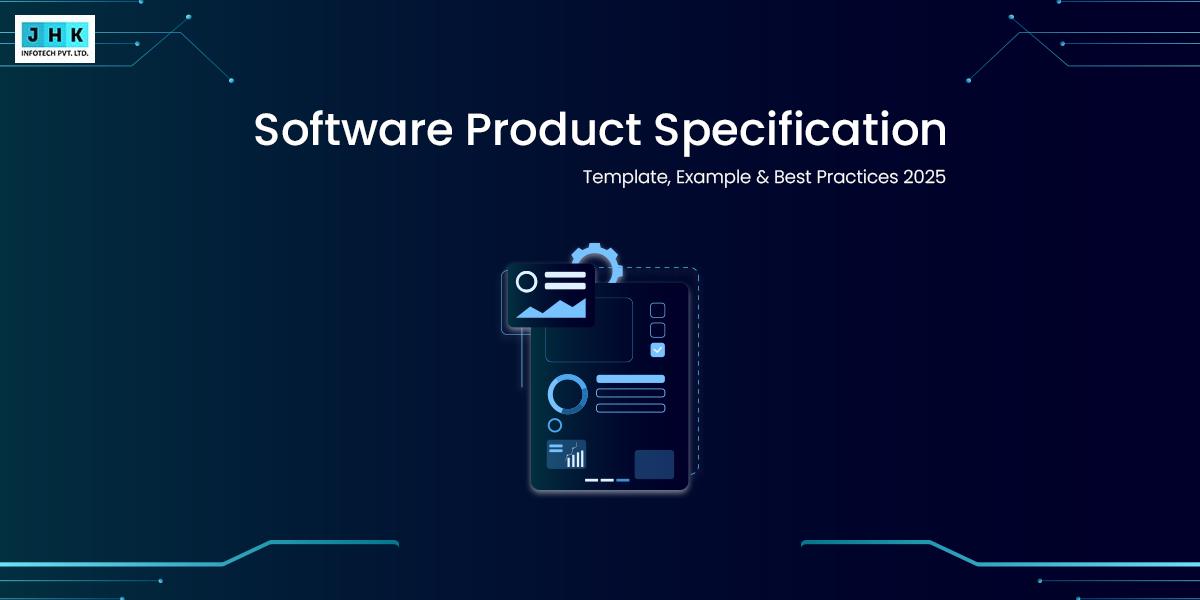23 Powerful Types of Software Design Patterns with Examples

Crafting code that is efficient, easy to maintain, and scalable remains one of the biggest challenges in modern software development. That’s where software design patterns come in. These proven solutions offer developers a blueprint for solving recurring design problems—whether you’re building enterprise-level apps, e-commerce platforms, or SaaS products. In this guide, we’ll explore the 23 most important design patterns every developer should know, complete with simple examples and use cases.
Design Patterns in Software Development
In software engineering, design patterns serve as time-tested solutions to common design challenges. These patterns provide a universal vocabulary that empowers developers to craft robust and elegant architectures, mitigating complexities in scalable applications. They are not code recipes, but abstract blueprints that enhance system design clarity and coherence.
At JHK Infotech, we apply industry-best practices to design scalable, secure, and future-ready applications tailored to your needs.
👉 Talk to Our Development Experts and see how we can transform your idea into a robust solution.
How Design Patterns Improve Code Reusability and Scalability
Design patterns bring modularity to development, promoting code reuse and minimizing redundancy. By encapsulating behaviors and responsibilities, they allow teams to scale systems seamlessly. From startups to enterprise platforms, design patterns facilitate maintainability and adaptability in dynamic environments.
What Are Software Design Patterns?
Definition and Concept of Software Design Pattern
A software design pattern is a reusable solution to a recurring problem within a given context in software design. These patterns are templates that guide the construction of software components and systems, ensuring consistency and best practices across development projects.
The Origins and Evolution of Design Patterns in Programming
The concept of design patterns originated in architecture through the work of Christopher Alexander and was later adapted to software by the Gang of Four (GoF) in their seminal 1994 book. Since then, patterns have evolved in step with emerging paradigms like microservices, cloud-native applications, and functional programming.
When and Why to Use Design Patterns in Software Projects
Design patterns should be applied when design dilemmas begin to surface—often during system growth or codebase refactoring. They shine in large-scale systems where architectural discipline is paramount. Patterns reduce technical debt and promote a shared understanding among developers.
Core Categories of Software Design Patterns
Overview of Creational, Structural, and Behavioral Patterns
Design patterns are typically segmented into three primary classifications:
- Creational patterns deal with object creation mechanisms.
- Structural patterns concentrate on how classes and objects are assembled and interrelated.
- Behavioral patterns manage communication between objects.
Each category addresses different facets of application architecture, allowing developers to tackle challenges at varying layers of abstraction.
Three Main Software Design Patterns Categories
Creational patterns abstract the instantiation process, structural patterns streamline interface relationships, and behavioral patterns orchestrate object interactions. Understanding these distinctions helps developers apply the right pattern to the right problem.
Creational Design Patterns
- Singleton Pattern: Ensure a Class Has Only One Instance The Singleton pattern is employed to ensure that a class has only one instance throughout the application lifecycle. This is particularly vital in scenarios such as configuration settings, logging mechanisms, or database connection pools where multiple instances could lead to conflicts or unnecessary resource consumption. With careful implementation—using double-checked locking or static initialization—developers can guarantee thread safety and controlled access, all while optimizing memory footprint.
- Factory Method Pattern: Delegate Object Creation to Subclasses This pattern defines an interface for object creation, allowing subclasses to alter the type of objects that will be created. It encapsulates the instantiation logic and enables flexibility by deferring the object creation process to subclasses. The Factory Method pattern is ideal in frameworks where library code needs to instantiate user-defined objects, thus promoting loose coupling.
- Abstract Factory Pattern: Create Families of Related Objects Abstract Factory provides a higher-level interface for creating families of related or dependent objects without binding the code to their specific classes. It’s frequently used in systems with multiple themes or operating system-dependent UI components. By centralizing the object creation logic, this pattern supports consistency among interrelated objects and enhances code portability.
- Builder Pattern: Construct Complex Objects Step-by-Step Builder separates the construction of a complex object from its representation so the same construction process can create different representations. It’s especially useful when an object requires numerous configuration options or nested structures. This pattern promotes immutability and readable object creation, often seen in fluent interfaces.
- Prototype Pattern: Clone Existing Objects Efficiently Prototype enables object duplication without depending on their classes, thus avoiding the overhead of instantiation. Especially useful in performance-sensitive contexts, the pattern facilitates the rapid generation of objects through cloning, sidestepping the complexities of constructors and initial configuration.
Structural Design Patterns
- Adapter Pattern: The Adapter pattern serves as a conduit, translating between mismatched interfaces to enable seamless collaboration. It wraps an existing class with a new interface, allowing classes with mismatched interfaces to work together seamlessly. This is particularly effective when integrating legacy systems with new modules.
- Bridge Pattern: Decouple Abstraction from Implementation Bridge separates abstraction from its implementation, allowing the two to vary independently. It’s a powerful pattern for handling cross-platform or multi-device software, where abstractions and their implementations evolve on separate tracks.
- Composite Pattern: Treat Objects as Tree Structures Composite structures objects into tree-like hierarchies, enabling uniform treatment of individual and composite objects. This pattern is often used in UI frameworks and document structures, where complex assemblies can be treated as singular entities.
- Decorator Pattern: Add Responsibilities to Objects Dynamically Decorator attaches additional responsibilities to an object dynamically without altering its structure. By wrapping objects in decorator classes, new behavior can be layered transparently, leading to cleaner alternatives than subclassing for extending functionalities.
- Facade Pattern: Facade provides a single, consolidated interface that encapsulates and streamlines interactions with multiple interfaces inside a subsystem. This pattern simplifies interaction with complex systems and provides a cleaner API to the client. It’s frequently used in layered architecture to reduce dependencies.
- Flyweight Pattern: Optimize Resource Usage with Shared Objects Flyweight minimizes memory usage by sharing as much data as possible with other similar objects. It is especially potent in scenarios involving large numbers of similar objects, such as character rendering or object pooling in games.
- Proxy Pattern: Control Access to Objects with Intermediaries Proxy acts as an intermediary that controls access to a target object. It can provide additional functionalities like access control, lazy loading, or logging. This pattern is common in security frameworks, remote object invocation, and resource-heavy object management.
Behavioral Design Patterns
- Chain of Responsibility Pattern: Pass Requests Along a Chain This pattern sends requests along a chain of handlers, decoupling senders and receivers. Each handler either addresses the request directly or forwards it onward, fostering adaptability while minimizing tight coupling between components.
- Command Pattern: The Command pattern converts a request into an independent object that encapsulates all details necessary for its execution. This abstraction enables features such as queuing, logging, and undo/redo capabilities. It plays a pivotal role in graphical user interface frameworks and automated task management systems.
- Interpreter Pattern: Define a Language Grammar for Interpretation Interpreter defines a grammatical representation and an interpreter to process expressions. It’s useful in compilers, configuration parsers, and domain-specific languages where syntactical rules need to be evaluated dynamically.
- Iterator Pattern: Traverse Collections Without Exposing Details Iterator provides a mechanism to access elements of an aggregate object sequentially without exposing its underlying structure. It promotes encapsulation and simplifies collection traversal logic.
- Mediator Pattern: Centralize Complex Communications Mediator centralizes communication between components, reducing the direct dependencies between them. This pattern proves exceptionally powerful in graphical user interface applications, where multiple widgets need to synchronize their behaviors seamlessly.
- Memento Pattern: Preserve and Reinstate Object State The Memento pattern enables the encapsulation of an object’s internal state, allowing it to be saved and subsequently restored when needed. It’s crucial in undo mechanisms and checkpointing systems where state recovery is necessary.
- Observer Pattern: Notify Dependents of State Changes Observer defines a one-to-many relationship, where state changes in one object are propagated to multiple dependents. It underpins event-driven programming and real-time systems such as stock tickers or notification services.
- State Pattern: Enable Dynamic Behavior Modification The State pattern empowers an object to modify its behavior dynamically in response to changes within its internal state. It is particularly useful in workflow and finite state machine implementations.
- Strategy Pattern: Define a Cohesive Set of Algorithms. The Strategy pattern encapsulates a collection of algorithms, treating each as a discrete entity, and enables seamless interchangeability among them. It enables clients to switch algorithms without altering the context, ideal for sorting, searching, and routing applications.
- Template Method Pattern: Establish the Algorithm’s Framework Within a Method. The Template Method pattern outlines the overarching structure of an algorithm in a base class, while granting subclasses the flexibility to override specific steps. This approach fosters code reuse and ensures uniform behavior throughout the subclass hierarchy.
- Visitor Pattern: Add Operations to Objects Without Modifying Them Visitor allows new operations to be performed on elements of an object structure without altering their classes. It is beneficial when a stable structure requires frequent, unrelated operations.
Real-World Use Cases of Software Design Patterns
Popular Applications That Use Design Patterns Modern development ecosystems like Android SDK, React.js, and .NET framework make extensive use of design patterns. Singleton patterns govern application-wide configurations, Factory patterns modularize component creation, and Observer patterns drive dynamic data-binding processes.
Industry Examples of Effective Design Pattern Implementation Tech giants like Amazon, Google, and Microsoft embed design patterns into their software architecture. Amazon’s recommendation engine utilizes the Strategy pattern, Netflix employs Proxy for service access, and Google’s event-driven tools rely heavily on Observer and Mediator.
Best Practices for Choosing the Right Pattern
How to Select the Appropriate Pattern for Your Project Selection hinges on problem diagnosis. Developers should assess the nature of the problem, project architecture, and future scalability requirements. Patterns should align with both the design goals and domain constraints.
Common Mistakes to Avoid When Using Design Patterns Overuse and misuse of patterns can obfuscate rather than clarify. Applying a pattern where a simple solution suffices introduces unnecessary complexity. Developers should resist the urge to force patterns into every design and prioritize simplicity and readability.
Tools and Frameworks That Support Design Patterns
IDEs, Libraries, and Plugins to Enhance Pattern Usage
Modern IDEs like IntelliJ IDEA, Visual Studio, and Eclipse come equipped with features and templates that assist with pattern-based development. Libraries like Apache Commons and Spring Framework heavily utilize design patterns internally.
Languages That Best Implement Design Pattern Concepts
Languages like Java, C#, Python, and TypeScript offer robust object-oriented capabilities, making them ideal for implementing design patterns. Functional languages are also adapting patterns in new forms, particularly in declarative programming.
Conclusion
From Singleton to Visitor, these 23 patterns provide a rich arsenal for developers aiming to write cleaner, more efficient code. They encapsulate design wisdom, promote consistency, and foster code reuse across projects of any scale.
Harnessing design patterns isn’t about memorizing formulas—it’s about elevating your architectural thinking. Apply them thoughtfully to create systems that are not only functional but resilient, scalable, and future-proof.
FAQ’s
What is a design pattern in software engineering?
A design pattern is a reusable solution to a common software design problem. It’s a general, proven template—not actual code—that developers can apply to speed up development and improve software structure.
When should I use design patterns?
Use design patterns when you face recurring problems in architecture or code design. They’re especially helpful in large projects where scalability, readability, and modularity matter.
What are software design patterns?
Software design patterns are structured, reusable solutions developed to address frequently encountered problems in software development. These patterns help create organized, reusable, and maintainable code structures.
What are design patterns in software development?
Design patterns in development are standard approaches to solving problems related to object creation, structure, and behavior in your software. They promote better design practices.
How many types of design patterns are there?
There are three main categories:
- Creational (e.g., Singleton, Factory)
- Structural (e.g., Adapter, Composite)
- Behavioral (e.g., Observer, Strategy)
Each category addresses different design challenges.









